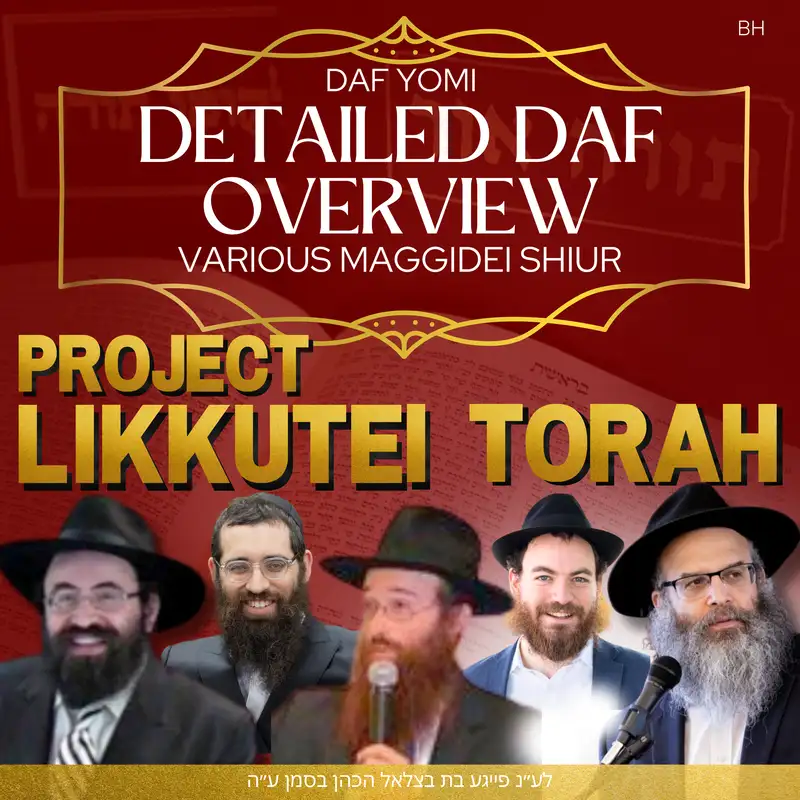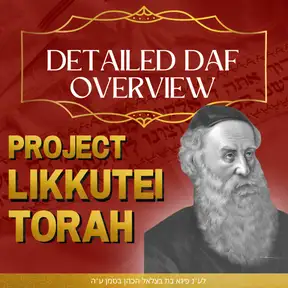
Torah Ohr Daf 81 Lighting the Lamps of our Souls w/ Rabbi Dovid Leib Shmerling
Summary
To sponsor an entire parshah, please email projectlikkuteitorah@gmail.com“Veatah Titzaveh es Binei Yisroel vayikchu eilecha shemen zayis zuch…”Q1: If Aharon is the one lighting the candles, why does it say “vayikchu eilecha”, which seems to imply that the oil is brought to Moshe?Q2: In the posuk which refers to Moshe, it says that the candles should be lit constantly (tamid), whereas by Aharon it says “m’erev v’ad boker”.Aharon is the one who brings Binei Yisroel closer to Hashem by revealing the quality of Simcha in Avodas Hashem, which is synonymous with the fact that Or Ein Sof is present and accessed through Torah and Mitzvos. Mitzvos are the source of the incomparable pleasure found in all of the infinite levels of Gan Eden.Now, although one of the effects of kium Hamitzvos is that we “store up” the divine pleasure we will have in Gan Eden, the Joy we experience when we actually fulfill the Mitzvos needs to be based on the realization that the Mitzvos themselves, in contrast to their effects, are actually expressions of Or Ein Sof, which is infinitely beyond the pleasure caused by Mitzvos in Gan Eden (tachas asher lo avadita es Hashem Elokecha bisimcha uvituv leivav m’rov kol). This Joy in the actual fulfillment of the Mitzvos is what Aharon provides Bnei Yisroel. This happens in two stages: Preparing the wicks= ones self-initiated attempt to connect to Hashem through hisbonenus, which occurs during Pesukei Dezimrah.Lighting the wicks= the Love form Hashem which is a gift from above, which occurs during Krias Shema (Ahavah d’Bchol Meodcha).This is why we say “m’erev v’ad boker” when referrint to Aharon: the love for Hashem/Simcha shel Mitzvah happens in stages; we proceed from spiritual darkness to ever increasing illumination (=Ahavah).However, prior to both of these is the Oil, which represents both the crushing of one’s physical desires and the ego generally, and the resulting oil=Chochma=Bittul, which is the fuel for the Simcha Shel Mitzvah. Without this fuel, one cannot maintain the feeling of Simcha when fulfilling the Mitzvos, and the Gilui Or Ein Sof which is the source of that Joy. That the Menorah is lit outside the Paroches represents the fact that the entire experience described above happens in the reality of Yichuda Tataah, Shem Elokim, in which we are self-conscious but also attempt to subsume ourselves completely in Elokus, Yichudah Illah (harazui shel Ahavah d’Bchol Meodcha). Another prerequisite for this love is the study of Torah, represented by Moshe. This represents Shuv, Yichudah Ilaah, which is in a way higher than Ratzui. But this is accomplished specifically by those whose primary mode of avodah is Torah (Toraso umanuso), such as Rashbi. Even such great scholars need to preface their Torah learning with Bittul, which comes through hisbonenus on Bitul Haolamos. “Veateh Tetzaveh…”= the two ways we connect to Hashem (tzavsah vechibbur) through Mitzvos, and, at a deeper level, Torah, which are provided for us by Aharon and Moshe, respectively. Support the showTo sponsor an entire parshah, please email projectlikkuteitorah@gmail.com
- “Veatah Titzaveh es Binei Yisroel vayikchu eilecha shemen zayis zuch…”
- Q1: If Aharon is the one lighting the candles, why does it say “vayikchu eilecha”, which seems to imply that the oil is brought to Moshe?
Q2: In the posuk which refers to Moshe, it says that the candles should be lit constantly (tamid), whereas by Aharon it says “m’erev v’ad boker”.
- Aharon is the one who brings Binei Yisroel closer to Hashem by revealing the quality of Simcha in Avodas Hashem, which is synonymous with the fact that Or Ein Sof is present and accessed through Torah and Mitzvos. Mitzvos are the source of the incomparable pleasure found in all of the infinite levels of Gan Eden.
- Now, although one of the effects of kium Hamitzvos is that we “store up” the divine pleasure we will have in Gan Eden, the Joy we experience when we actually fulfill the Mitzvos needs to be based on the realization that the Mitzvos themselves, in contrast to their effects, are actually expressions of Or Ein Sof, which is infinitely beyond the pleasure caused by Mitzvos in Gan Eden (tachas asher lo avadita es Hashem Elokecha bisimcha uvituv leivav m’rov kol).
- This Joy in the actual fulfillment of the Mitzvos is what Aharon provides Bnei Yisroel. This happens in two stages:
- Preparing the wicks= ones self-initiated attempt to connect to Hashem through hisbonenus, which occurs during Pesukei Dezimrah.
- Lighting the wicks= the Love form Hashem which is a gift from above, which occurs during Krias Shema (Ahavah d’Bchol Meodcha).
- This is why we say “m’erev v’ad boker” when referrint to Aharon: the love for Hashem/Simcha shel Mitzvah happens in stages; we proceed from spiritual darkness to ever increasing illumination (=Ahavah).
- However, prior to both of these is the Oil, which represents both the crushing of one’s physical desires and the ego generally, and the resulting oil=Chochma=Bittul, which is the fuel for the Simcha Shel Mitzvah. Without this fuel, one cannot maintain the feeling of Simcha when fulfilling the Mitzvos, and the Gilui Or Ein Sof which is the source of that Joy.
- That the Menorah is lit outside the Paroches represents the fact that the entire experience described above happens in the reality of Yichuda Tataah, Shem Elokim, in which we are self-conscious but also attempt to subsume ourselves completely in Elokus, Yichudah Illah (harazui shel Ahavah d’Bchol Meodcha).
- Another prerequisite for this love is the study of Torah, represented by Moshe. This represents Shuv, Yichudah Ilaah, which is in a way higher than Ratzui. But this is accomplished specifically by those whose primary mode of avodah is Torah (Toraso umanuso), such as Rashbi. Even such great scholars need to preface their Torah learning with Bittul, which comes through hisbonenus on Bitul Haolamos.
- “Veateh Tetzaveh…”= the two ways we connect to Hashem (tzavsah vechibbur) through Mitzvos, and, at a deeper level, Torah, which are provided for us by Aharon and Moshe, respectively.
